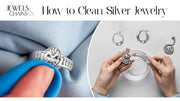Silver jewelry holds a special place in our collection and wardrobe. Whether it is a piece of valuable family, a bold statement accessory, or a daily wearer, silver jewelry brings elegance and style at a glance. However, tarnishing the natural tendency of silver can also leave the most beautiful pieces looking dull and sad. Understanding how to clean silver jewelry properly is important to maintain a bright appearance and increase its lifetime.
Unlike gold jewelry, silver requires extra frequent care because of its reactive nature with sulfur compounds in the air. The superb information is that with the right techniques and substances, you can restore your silver jewelry from your private home to its original condition. This distinctive manual will show you what you need to recognize about how to clean numerous varieties of silver jewelry competently and successfully.
Also Read: What Is Permanent Jewelry? Everything You Need to Know
What Causes Silver Jewelry to Tarnish
Understanding why silver tarnishing is important for proper care and maintenance. The tarnish occurs when the silver reacts with the sulfur compounds present in the air, forming a thin layer of silver sulfide on the surface. This chemical reaction manifests as a black, brown, or yellow colored malaise that dulls the natural glow of the metal.
Many factors accelerate the tarnished process:
Environmental factors play an important role in stigma formation. The oxidation process can be accelerated due to high humidity, air pollution, and exposure to household chemicals. Even rubber bands, wool fabrics, and some foods with sulfur compounds, such as everyday objects, can contribute to tarnish.
Body chemistry also affects how quickly silver tarnishes. Skin chemistry of some people causes rapid tarnishing of silver due to high acidity levels or drug interaction. Perfumes, lotions, and cosmetics can also accelerate the process of tarnishing when exposed to silver jewelry.
The storage conditions largely affect development. Direct contact with silver or other metals stored in a moist environment can make them more prone to tarnish than properly stored pieces.
Also Read: What Are Jump Rings? How to Use Them in Jewelry Making
Safety Precautions Before Cleaning Silver Jewelry
Before diving into cleaning methods, it is necessary to take proper safety precautions to save both yourself and your jewels. Always work in a well-ventilated area, especially when using chemical cleaners or acidic solutions. Wear gloves to protect your skin from cleaning agents and to prevent your fingers on fresh, clean silver.
Carefully check your jewelry before cleaning. See loose stones, weak claps, or damaged areas during the cleaning process. If you notice any structural issues, consider taking a piece of a professional jeweler before trying to clean yit ourself.
First, test any cleaning method on a small, inconspicuous area to ensure that it will not damage the jewelry. It is particularly important for pieces with finish, petinus or mixed metals.
DIY Methods for Cleaning Silver Jewelry
Baking soda and water method
The baking soda and water method is one of the gentlest approaches to brighten silver jewelry. Create a paste using three parts baking soda in one part water, until you achieve a thick consistency. Using a soft-bristled toothbrush or a fabric, gently apply the paste to the tarnished areas in a circular motion.
This method especially works well for lighting, cleaning, and regular maintenance. The mild abrasive of baking soda helps to tarnish the surface without scratching the metal. After cleaning, rinse well with lukewarm water and dry immediately with a soft cloth to prevent water spots.
Vinegar and baking soda method
For more stubborn stains, a combination of vinegar with baking soda creates a powerful cleaning solution. Mix two tablespoons of baking soda with half a cup of white vinegar in a bowl. The resulting fizzing response helps in breaking down effectively, tabling.
Soak the small pieces in this solution for 15-20 minutes, then gently scrub with a soft brush. For large pieces, apply the mixture with a cloth and let it sit for several minutes before scrubbing. This method is excellent for removing moderate to heavy stigma, but should be used with restraint to avoid over-cleaning.
Lemon juice and salt method
The acidic properties of lemon juice combined with the abrasive properties of salt make it a natural and effective silver cleaning method. To create a paste-like stability, mix half a lemon juice with one teaspoon of salt.
Apply this mixture in tarnished areas and let it sit for 5–10 minutes. Gently scrub with a soft cloth or brush, paying special attention to cracks and wide areas. This method works well for complex pieces with wide designs where the stigma is accumulated.
Commercial Silver Cleaners
Commercial silver cleaners offer convenience and are formulated especially for silver care. These merchandise generally include chemical compounds designed to dissolve tarnish quickly and safely. Popular options include silver sprucing cloths, liquid cleaners, and foam cleaners.
When using business cleaners, usually follow the producer's commands cautiously. Most require you to apply the purifier, wait a specific time, then rinse and dry very well. While those products are effective, they must be used judiciously as common use can regularly put down the silver surface.
How to Clean Sterling Silver Jewelry
Sterling silver, composed of 92.5% pure silver and seven.5% different metals (typically copper) call for unique care due to their composition. How to clean sterling silver jewelry correctly includes knowing its particular characteristics and vulnerabilities.
Sterling silver tends to tarnish more slowly than fine silver because of its alloy composition; however, it could nonetheless develop a patina over time. The copper content makes it barely greater durable but also greater susceptible to green discoloration in positive situations.
For sterling silver portions, start with the gentlest cleaning approach possible. The baking soda paste method works excellently for ordinary maintenance. For deeper cleansing, use the vinegar and baking soda approach, but limit exposure time to prevent harm to the copper alloy.
Professional jewelers propose cleaning sterling silver jewelry every few months, depending on wear frequency and storage situations. Pieces worn each day might also need more frequent attention, at the same time as occasional-wear objects can be wiped clean less often.
How to Clean Silver Plated Jewelry
Silver plated rings gives particular demanding situations due to the fact that the silver layer is extremely thin and can be easily broken or worn away. How to clean silver plated jewelry calls for greater caution to hold the delicate silver coating.
The key to cleansing silver plated pieces is using the mildest strategies possible. Avoid abrasive substances and harsh chemical substances that would strip away the silver plating. The baking soda and water paste technique is frequently the safest choice for silver plated objects.
Never soak silver plated earrings for prolonged intervals, as this may cause the plating to split from the bottom metal. Instead, clean quickly and gently, then dry right now and punctiliously. If the plating has worn through in regions, recall having the piece re-plated by means of a professional jeweler in place of attempting competitive cleaning strategies.
How to Clean Tarnished Silver Jewelry
Heavily tarnished silver rings require patience and the right approach to restore their authentic beauty. How to clean tarnished silver jewelry depends on the severity of the tarnish and the kind of silver you are working with.
For intense tarnish, start with the lemon juice and salt method, as the acidic solutions assist in dissolving stubborn tarnish buildup. Apply the combination and allow it to work for 10-15 mins earlier than lightly scrubbing. You might also need to repeat this process numerous times for closely tarnished portions.
The aluminum foil technique is every other powerful method for severely tarnished silver. Line a bowl with aluminum foil, add hot water and a tablespoon of baking soda, then submerge the tarnished rings. The chemical response among the aluminum and silver helps do away with tarnish with out scrubbing. This technique works particularly well for chains and tricky portions in which guide scrubbing is hard.
For antique or precious portions with full-size tarnish, consider consulting a professional jeweler. They have specialized equipment and knowledge to smooth silver at domestic might not be enough for extraordinarily treasured or sensitive objects.
Dos and Don'ts of Silver Jewelry Care
Dos:
-
Clean regularly to prevent heavy tarnish buildup
-
Use soft cloths and brushes to avoid scratching
-
Dry thoroughly after cleaning to prevent water spots
-
Store properly in anti-tarnish pouches or cloth
-
Remove jewelry before swimming, exercising, or using cleaning products
-
Polish gently in one direction rather than circular motions
Don'ts:
-
Use harsh chemicals like bleach or ammonia
-
Clean with abrasive materials like steel wool
-
Soak silver-plated jewelry for extended periods
-
Use ultrasonic cleaners on pieces with loose stones
-
Store silver jewelry in humid environments
-
Wear silver jewelry when applying lotions or perfumes
Tips to Prevent Tarnish
Prevention is always better than a cure when it comes to silver jewelry care. Proper storage is crucial for maintaining your silver's appearance. Store pieces in a cool, dry place, preferably in individual anti-tarnish pouches or wrapped in acid-free tissue paper.
Silica gel packets can help absorb moisture in storage containers, while anti-tarnish strips provide additional protection against sulfur compounds. Avoid storing silver jewelry in bathrooms or other humid areas where moisture can accelerate tarnishing.
Regular wear helps prevent tarnish, as the natural oils from your skin create a protective barrier. However, remove silver jewelry before activities that might expose it to chemicals or excessive moisture.
Consider investing in a jewelry box with anti-tarnish properties or lining your current storage with anti-tarnish cloth. These preventive measures can significantly extend the time between cleanings and help maintain your silver's lustrous appearance.
Conclusion
Maintaining the beauty of your silver jewelry doesn't have to be complicated or expensive. With the right knowledge and techniques, you can keep your silver pieces looking brilliant for years to come. Whether you're dealing with sterling silver, silver plated items, or heavily tarnished pieces, the methods outlined in this guide provide safe and effective solutions for every situation.
Remember that regular maintenance is key to preserving your silver jewelry's appearance. By incorporating these silver cleaning methods into your jewelry care routine and following proper storage practices, you can ensure your silver pieces continue to shine and complement your style. The investment of time and care you put into learning how to clean silver jewelry properly will pay dividends in the longevity and beauty of your precious accessories.
With these proven tips and techniques, you're well-equipped to tackle any tarnish challenge and keep your silver jewelry collection looking its absolute best. Whether it's a family piece or a new purchase, proper care will help maintain its value and beauty for generations to come.


